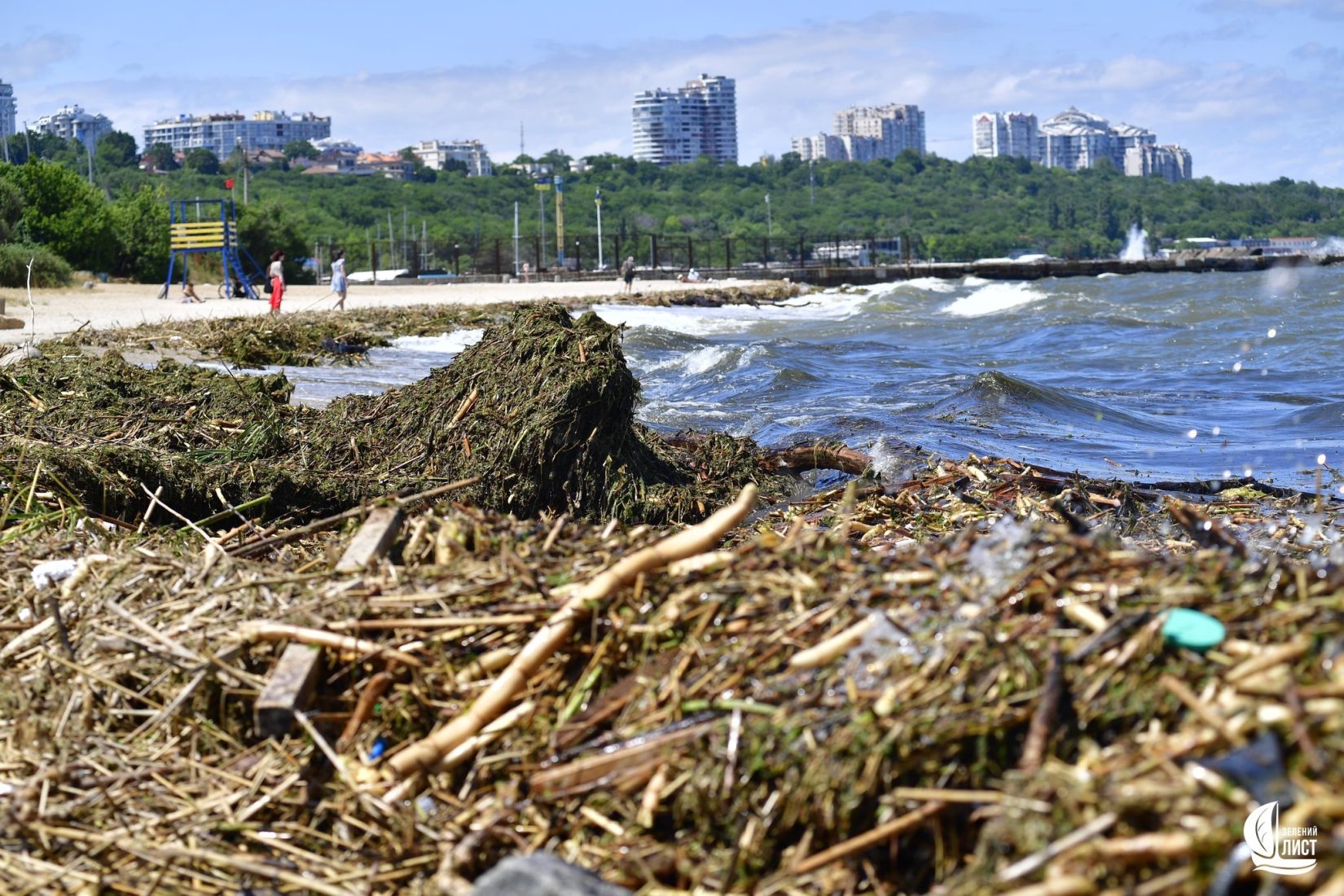On 6 June 2023, the Russian occupiers carried out one of the biggest terrorist attacks on the territory of Ukraine – they blew up the dam of the Kakhovka hydroelectric power station. Ukrainian officials consider the explosion an ecocide and a war crime. Even now, almost a year and a half after the tragedy, it is impossible to assess the full consequences of the disaster. In addition to human casualties and material damage, the destruction of the dam, which caused extensive flooding of areas, and the devastation of the Kakhovka reservoir, caused a humanitarian and man-made disaster, destroyed the landscape, altered ecosystems, polluted aquifers, and polluted the coast and water bodies.
Perhaps in decades to come, our descendants will refer to the Kakhovka disaster and its impact on the environment and the Black Sea as the second Chernobyl.
The course of events
6 June 2023:
- At 6am the organisation ‘Pivden‘ reported that the Russian occupiers had blown up the dam of the Kakhovka hydroelectric power station.
- at 06.45 – Oleksandr Prokudin, head of the Kherson Regional Military Administration, announced the evacuation due to the threat of flooding. Prokudin noted that water will reach a critical level in 5 hours.
- At 8 a.m. the Kherson City Council announced that the Korabel neighbourhood in Kherson was cut off due to the threat of flooding, and also reported that gas supply was cut off. At around 9 o’clock the area began to flood.
- the water level in the Kakhovka reservoir began to drop rapidly, by about 15 cm per hour.
At around 10 a.m. the Office of the Prosecutor General announced that a criminal case had been opened on the facts of ecocide and violations of the laws and customs of war. In the morning a zoo in Nova Kakhovka (territory occupied by Russian troops – ed.) was flooded “Fairy Tale Grove”, a summer theatre, a monument to Shevchenko, a coffee shop, a playground in the city, a boat station, and a yacht club. The mayor of Nova Kakhovka Volodymyr Kovalenko also reported about the approach of water to Dniprovskyi Avenue and the unstable operation of Internet in the city. In his opinion the Russians were “jamming communications” in order to leave the townspeople in an information vacuum.
7 June 2023:
a rise in water level of approximately 5 metres at the Kherson post since the accident. In Nikopol (above the destroyed dam), the water level has dropped to 2.2 metres. By according to Ukrhydroenergo’s preliminary forecast, water from the Kakhovka reservoir is expected to be fully released into the lower reaches of the Dnipro River by 12 June 2023. This is a volume of 18.2 km of water. “The Kakhovka reservoir will be emptied very quickly. This means a bare bottom with silt and the death of hundreds of plant and animal species. This will lead to a shortage of drinking water and drought throughout the south, which was supplied with water from Kakhovka hydroelectric power station. These are eroded cattle cemeteries, burial grounds, and ordinary burials that will end up in surface waters in the lower reaches of the Dnipro River,” said Ruslan Havryliuk, head of the National Ecological Centre of Ukraine.
- 1700 people were evacuated.
- 29 settlements were flooded, 19 of which were in the government-controlled area.
8 June 2023:
- the water level in the Kakhovka reservoir in the evening was 12.5 metres, which is below the so-called “dead point”, below which water intake is impossible, half of the station was under water, the other half by 70%. The earthen insert between the lock and the station was also under water and was being eroded.
- The average flood level is 5.61 metres. 600 km² of Kherson region are under water, of which 32% are right bank and 68% on the left bank.
- Tyahynka, Lvov, Odradokamyanka in Beryslav district, Ivanivka, Mykilske, Tokarivka, Poniativka, Bilozerka, and the Ostrov neighbourhood in Kherson are completely or partially flooded.
- The state managed to evacuate 2198 people. During the evacuation the Russian military shelled Kherson injuring 9 people.
9 June 2023:
The Kakhovka reservoir continued to shrink with a total water drop of 4.7 metres. As of the morning the reservoir level in the Nikopol area was 11.74 metres. Every second, about 40,000 cubic metres of water leaked out of the reservoir.
10 June 2023:
- the water level in the Nikopol area dropped to 10.42 metres, and in the cooling pond Zaporizhzhya NPP is 16.67 m, and this is enough to meet the needs of the plant, Energoatom assured.
11 June 2023:
- The level of the Kakhovka reservoir near Nikopol was 9.35 metres. The water level dropped by more than a metre overnight, and by more than 7 metres since the explosion.
- 2,678 people were evacuated from the territory of Kherson region.
Within four days of the dam’s destruction, 18 cubic kilometres of water flowed down the Dnipro, flooding more than 620 square kilometres and 80 settlements. According to official figures, dozens of people died. However, the true toll of this disaster will only be known once the affected area has been cleared. Up to 1 million people lost access to drinking water.
In October, the Ukrainian government estimated the cost of the disaster at around $14 billion. Almost half of this figure – $6.4 billion – is an estimate of lost ecosystem services due to chemical pollution and habitat destruction along the Dnipro, one of Europe’s largest rivers.
The water from the Kakhovka reservoir was used to irrigate agricultural land, which covered about 200,000 hectares and was used to grow sunflower, grain and vegetables. ‘When the base of the Kakhovka dam was blown up, the engine room was also destroyed, and there were approximately 450 tonnes of fuel oil in this engine room. 150 tonnes are now in the Dnipro River and are flowing at high speed through Kherson and further down,’ Ukrainian Interior Minister Ihor Klymenko said on 6 June.
The destruction of the Kakhovka hydroelectric power station dam and subsequent flooding has washed a toxic stream into the Black Sea, including mines, chemicals, sewage, dead animals, cemetery burials, and toxic silt deposits. The entire Dnipro River basin is an industrial area with a large number of mines and factories that have remained since Soviet times. Manganese, arsenic, lead and cadmium are typical elements used in these industries.
A poisoned ‘lullaby’
After the dam was destroyed, the water from the Kakhovka reservoir began to flow rapidly towards the Black Sea. Within hours it was in the Dnipro-Bug estuary, a day later in the Black Sea, two days later off the coast of Odesa, and a week later on the banks of the Danube. The powerful wave of water brought to the coast of the Odesa region parts of destroyed houses, household appliances, dead and even live animals – not only domestic but also wild ones, pieces of land torn from the land with reeds and trees.


Satellite images clearly show that the plume of dirty water, which includes silt lifted from the bottom of the reservoir, fertile soil from flooded areas and the remains of washed-away settlements, is joining the currents of the north-western part of the Black Sea and heading south towards the coast of Romania and Bulgaria.
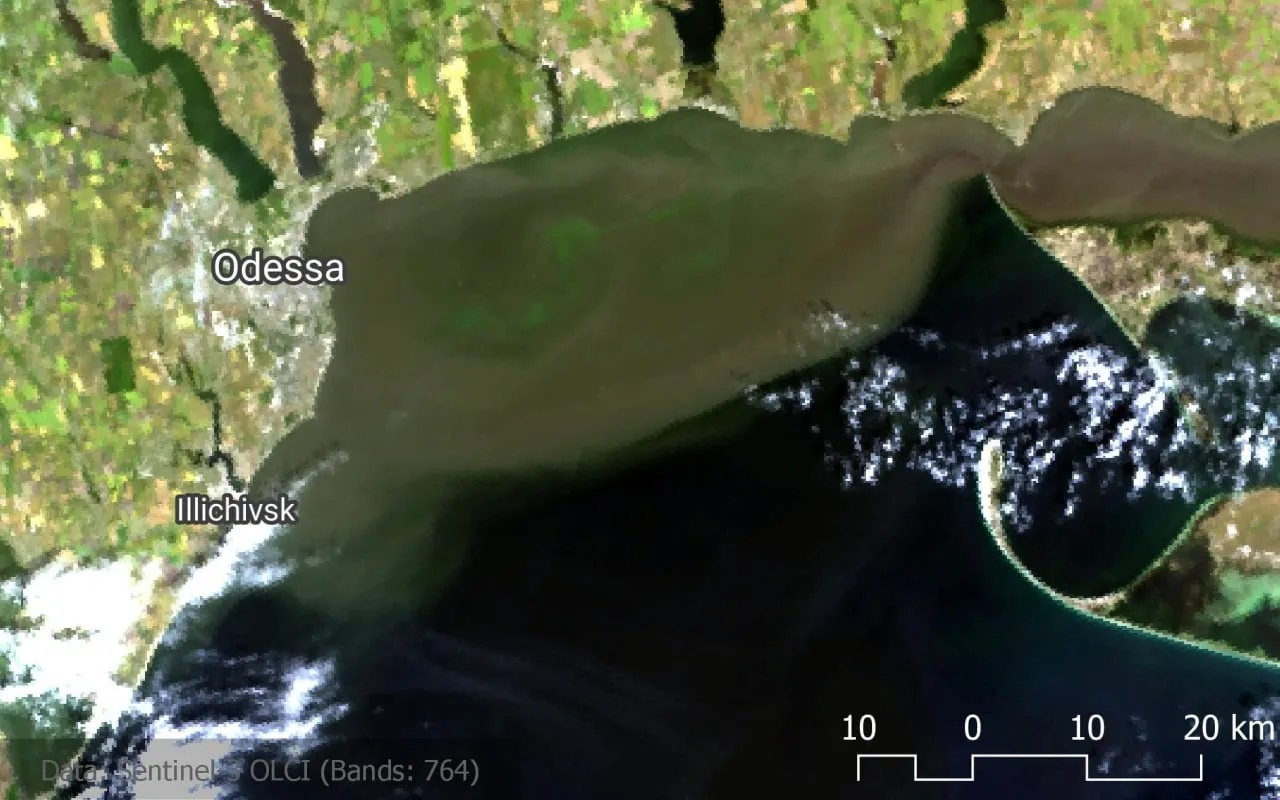
Sentinel-3 OLCI image taken on 2023-06-10 11:26 Kyiv time. Image courtesy of the Ukrainian Nature Conservation Group
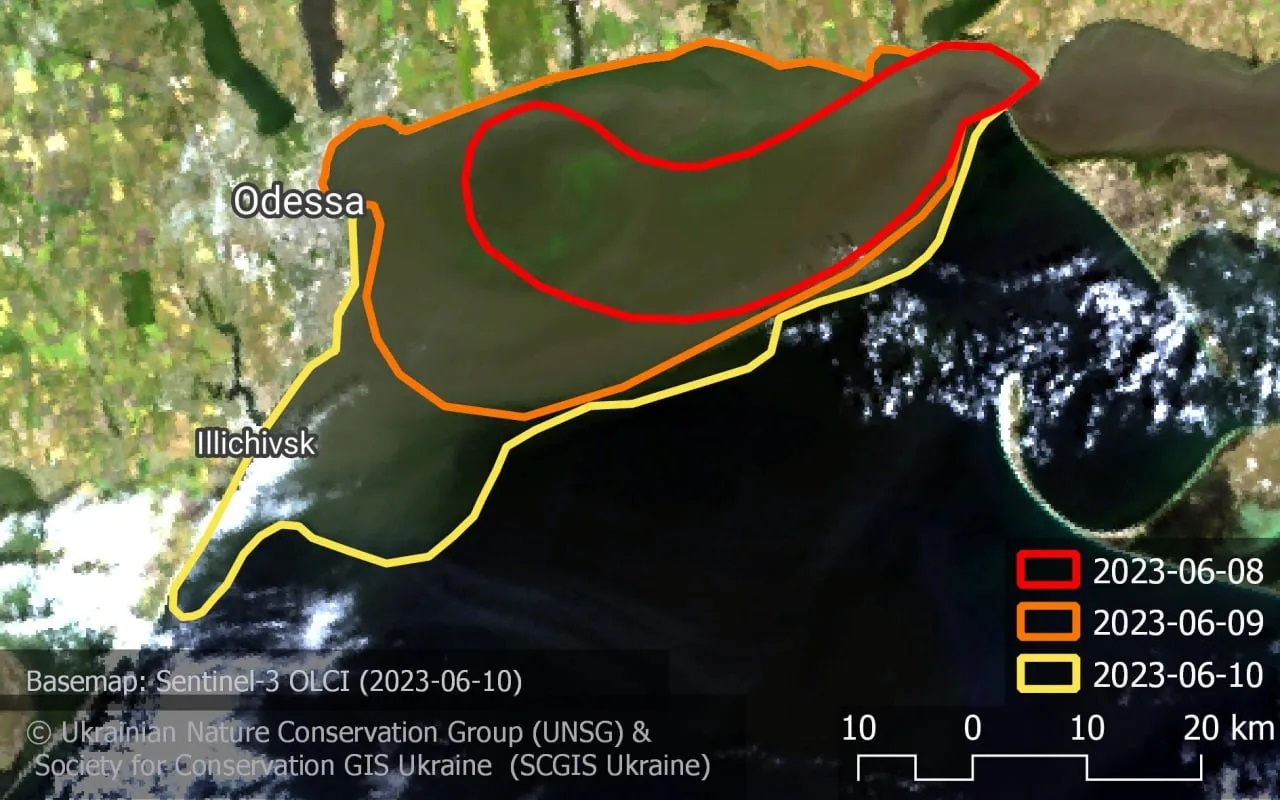
On 6 June, the area of sea siltation was 616.8 km², on 9 June – 1248.2 km², and on 10 June – 1710 km². Image courtesy of the Ukrainian Nature Conservation Group.
The southwestern part of the Black Sea between Odesa and the Danube Delta has been hit hardest. This part of the shelf, which is adjacent to most of the shallow Black Sea estuaries, is the most valuable for biodiversity and plays an important role in the reproduction of aquatic organisms. No wonder it is called the “cradle of the Black Sea”.
The Kakhovka wave brought with it two powerful negative impacts on the marine ecosystem – desalination and seawater pollution.
According to laboratory tests conducted by the State Ecological Inspectorate of the South-Western District of Ukraine, which took seawater samples in three different locations in and around Odesa, as of 10 July 2023, the salinity of the sea water had dropped by almost three times the normal level. Fresh water from the Kakhovka Reservoir entered the Black Sea 3-4 days after the dam breach and reached the coast of Odesa, reducing the normal salinity of sea water from the usual 17-18 ppm to 4 ppm.
The Ukrainian Scientific Centre for Marine Ecology (UkrSCES) reported that, according to satellite data, during the first week after the dam’s destruction, polluted river water covered more than 7,300 km2 of the north-western shelf of the Black Sea.

Map of the spread of contaminated river waters after the Kakhovka hydroelectric power station dam explosion according to satellite images. Source: UkrSCES
“The water from the Kakhovka Reservoir did not just flow over the surface, it displaced sea water,” said Viktor Komorin, Acting Director of UkrSCES, at the roundtable discussion “The Impact of Military Operations on the Marine Ecosystems of Ukraine” held on 30 May 2024.
According to Viktor Komorin, such an unnatural amount of fresh water in the sea is “a man-made disaster”.
Desalination leads to the growth of blue-green algae. When they bloom in the sea, there is not enough oxygen for living organisms and they die. The increase in blooms and decrease in salinity affects zooplankton, fish and dolphins. The extinct phytoplankton sinks to the lower layers of the sea and absorbs large amounts of oxygen, turning oxygen zones into hydrogen sulphide zones.
To assess possible threats to the Black Sea marine ecosystem as a result of the Kakhovka disaster, the Institute of Marine Biology of the National Academy of Sciences of Ukraine (IMB) conducted intensive monitoring of the marine ecosystem.
Since 6 June, the IMB staff has carried out expeditionary work in various districts of Odesa Oblast (Lanzheron, Malyi Fontan, Fontanka village, border with Mykolaiv Oblast). On 11 June, 2023, an ultra-high concentration of ammonium nitrogen was recorded in desalinated sea waters – 2 MPC. Similar concentrations of ammonium nitrogen were recorded near the village of Koblevo (Mykolaiv region). This increase in ammonium nitrogen concentration may be due to direct pollution from sewage flushing as a result of flooding of collectors, cesspools, etc. on the path of water flow from the Kakhovka Reservoir.
On 11 June, alarming information appeared on the IMB website: “The formation of acute water toxicity was noted in a sample from Langeron beach”.
Due to a significant deterioration in the condition of the water in the sea and a real danger to public health, the Commission on Technogenic and Environmental Safety and Emergency Situations of the Executive Committee of the Odesa City Council banned swimming on the beaches of Odesa and recommended refraining from eating fish and seafood of unknown origin. Based on the results of laboratory tests (virological, microbiological, parasitic) of water samples, the laboratories of the Odesa Regional Centre for Disease Control and Prevention of the Ministry of Health of Ukraine identified infectious agents in mid-June 2023, in particular, Salmonella enteritidis and Tifimurium, rotaviruses and astraviruses, cholera-like NAG vibrios, cholera-like vibrios Alginolithicus, parahaemolyticus, eggs and larvae of helminths of both humans and animals (pinworms, roundworms, dog roundworms, cryptosporidium oocysts). In addition, the LPC index (lactose-positive E. coli) significantly exceeded the regulatory requirements. The presence of all of these biological pathogens in the water of open water bodies in Odesa Oblast, including the Black Sea, the Bilhorod-Dnistrovskyi Estuary and the Danube River, posed a real threat to the life and health of the population.
In mid-June, in their latest report , IBS staff analysed satellite imagery and recorded a tenfold increase in the usual level of deviations of various indicators, which is associated with the penetration of organic matter into the sea (turbidity, chlorophyll A content, and the content of suspended solids in the water). “This carries the risk of increasing the trophicity of the aquatic ecosystem, the development of microorganisms, microalgae blooms, and a general deterioration in conditions for biological communities,” the experts concluded.
In mid-June, IBS scientists stated: “The flow of river waters from the Kakhovka Reservoir into the northwestern part of the Black Sea caused algal blooms, during which, as of June 15, 2023, the concentration of chlorophyll A on average for the entire area of the northwestern part increased by two times, which is a positive anomaly of this indicator by more than 80%. At the same time, in some areas located along the course of river waters from the Dnipro-Bug Estuary, the value of this indicator exceeded the value of 100 mg/ cubicmeter, i.e. increased almost more than 90 times.”

Areas and concentration of chlorophyll a in the northwestern part of the Black Sea as of June 15, 2023. Image – IBS.
The analysis of satellite images shows that almost half of the area of the NWHZ (45.8%) as of 15.06.2023 is covered by the consequences of the Kakhovka Reservoir water entering the sea. About 1,500 km² are covered by severe algal blooms. Heavily contaminated areas (oil products, organic matter) cover about 6000 km².
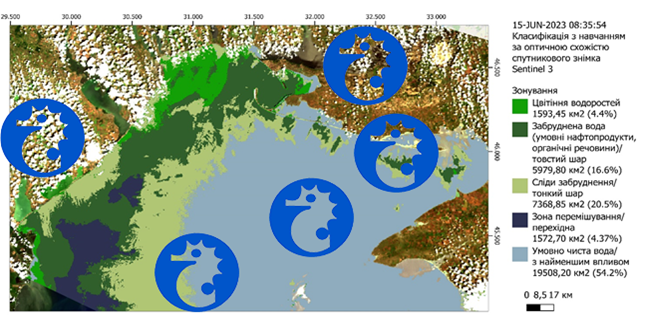
The consequences of the Kakhovka Reservoir’s water entering the southwestern part of the Black Sea. Image courtesy of IBS.
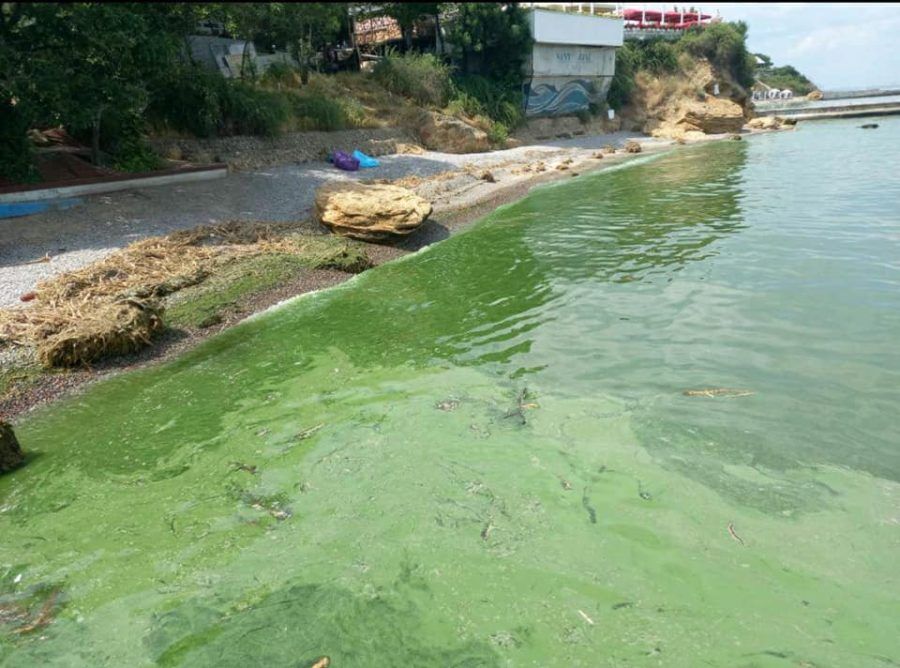
Vladyslav Balinsky, head of the Green Leaf NGO, also observed the active process of “sea bloom”. On 22 June, the Black Sea coast of Odesa was covered by a “red tide”. This happens when toxic algae – dinoflagellates – develop rapidly in seawater.

Sea blooms have been observed on the Odesa coast for several years. However, it used to be a local phenomenon, usually associated with a significant increase in air temperature in summer. During spring floods and heavy rainfall in summer, eutrophication processes are observed within the north-western shelf of the Black Sea, i.e. an increase in the concentration of anthropogenic biogenic chemicals. The increase in sea water temperature leads to a rapid growth of phytoplankton.
“Now the bloom has spread from the Gulf of Odesa to the Turkish coast,” said Viktor Komorin, PhD in Geography, Acting Director of UkrSCES. “This situation, when the entire coast is blooming, happens only at the end of summer, not at the beginning. Therefore, it is clear that this was caused by the accident at Kakhovka.”
In the case of the red tide, the phenomenon is caused by the rapid growth of unicellular photosynthetic dinoflagellate algae with a predominant number of Lingylodinium polyedra. The toxins released by these microalgae pose a threat to fish, shellfish and other marine organisms, and can also be dangerous to people who come into contact with contaminated water or consume seafood from the affected areas.
At the end of June, the water bloom even reached the Zernove Phyllophora Field Botanical Reserve, a unique accumulation of red algae from the Phyllophora genus located near Zmiinyi Island.
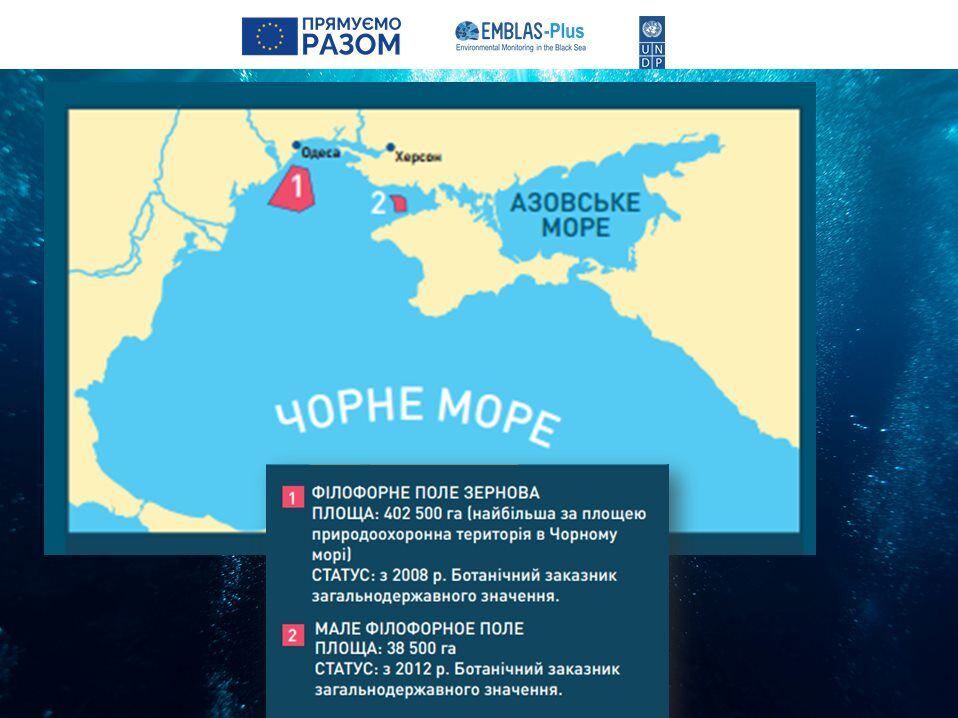
Picture from the Facebook page Fans of the Black Sea
Yurii Tkach, Senior Research Scientist at the IBS, Doctor of Biological Sciences, says that according to satellite data, the sea water above this protected area was blooming until early August. The suffocation caused by the bloom is dangerous not only for fish and shellfish, but also for the Red Book’s phyllophora. But it is impossible to check the condition of the reserve now.
A ticking time bomb
But the state of the water is only part of the problem. The flow of Kakhovka water carried downstream a mixture of sediments from the reservoir and flooded areas. UkrSCES staff, together with volunteers from the environmental movement Let’s do it Ukraine, took samples of water from the Dnipro River near Kherson, the Dnipro-Bug Estuary, the Black Sea near Ochakiv, and the Gulf of Odesa, and analysed it for toxic contamination. The analysis showed that the level of pollution in all four locations is equally dangerous. At all locations, concentrations above the maximum permissible concentration for oil products, toxic metals such as zinc, cadmium and arsenic, and organochlorine compounds such as lindane and PCBs were detected. The latter are chemical compounds that, once ingested, can cause malignant tumours.
The high concentration of carcinogenic compounds is due to the fact that sediments in the Kakhovka reservoir could have accumulated over the years, coming down from downstream industrial plants. The sediments accumulated pollutants from industry and agriculture, including toxic pesticides that are now banned.
And these sediments could be a real time bomb for many years to come. According to the leader of the environmental movement Let’s do it Ukraine, Yulia Markhel, the garbage and heavy metals from the bottom of the Kakhovka reservoir have not disappeared, they have settled to the seabed and rise again to the upper layers of sea water during storms.
Metals such as zinc and cadmium are toxic to many species of aquatic organisms, especially at high concentrations. They can affect reproductive, growth and other biological processes in marine organisms. Even if individual species can withstand high levels of copper and zinc, these metals can accumulate in the food chain, leading to even higher concentrations in organisms that are higher up the food chain, such as marine mammals or humans. People who eat seafood or drink water containing high levels of copper or zinc may experience health problems, including liver, heart, kidney or nervous system problems.
The highly toxic organochlorinated compounds heptachlor and PCBs can be dangerous to many species of aquatic organisms, including fish and invertebrates. They can cause damage to the nervous system, leading to paralysis and death. These pollutants tend to accumulate in the tissues of organisms, especially in fatty tissues. This means that they can accumulate in the food chain, causing even greater harm to organisms at the upper levels of the food chain, including humans.
Therefore, it is extremely important to continue studying the composition of these sediments and not only to predict their impact on ecosystems, but also to develop recommendations for neutralising such poisoned sites.
In 2024, the Czech NGO Arnika and its Ukrainian partners Free Arduino (Ivano-Frankivsk) and Green World (Dnipro) conducted a study of sediments from the Dnipro River and soil samples in Zaporizhzhia Oblast as part of the Clean Air for Ukraine project.
To determine the level of risk posed by possible contamination of the riverbed sediments, the researchers analysed fourteen samples: eleven from the sediments of the former Kakhovka Reservoir, two soil samples from the impact craters of the Russian S-300 missile, and one soil sample from the industrial area of Zaporizhzhia. The samples were tested for a wide range of contaminants. Many hazardous toxic substances were found in the samples, including heavy metals: arsenic, cadmium, manganese, chromium, lead, nickel, and titanium. However, the researchers were most concerned about the levels of DDT, 16 PAHs and C10-C40 hydrocarbons in the Dnipro River sediment sample in Zaporizhzhia.
The National Ecological Centre of Ukraine (NECU) is also studying the sediments accumulated in the Kakhovka Reservoir, in particular, as part of the SUNDANSE project. The project aims to develop innovative and sustainable solutions for sediment management in the Danube-Black Sea system, addressing critical environmental issues related to sediments and contributing to the health and sustainability of our waterways.
The Ukrainian project participants – NECU and the Danube Hydrometeorological Observatory – will develop a Sediment Management Manual for the Danube River Basin, which will allow to investigate the impact of pollutants on human activities and biodiversity in the Black Sea ecosystem. The research will also focus on the transmission of microplastics through the food chain and the assessment of the terrorist attack on the Kakhovka hydroelectric dam through the food chain.
Impact on wildlife
“The consequences of the Kakhovka ecological disaster had a significant negative impact on the aquatic biological resources of the Odesa region,” scientists conclude in the IBS study on the impact of the Kakhovka disaster on the Black Sea shelf ecosystem.
Three days after the 9 June disaster, a mass of fresh water with hundreds of so-called ‘quicksand’ – clusters of reeds clinging to their roots – was moving rapidly towards the Gulf of Odesa near the village of Fontanka. Along with the quicksand, various organisms that had been washed out of the Dnipro Delta, including frogs, crustaceans, freshwater and terrestrial mollusks, and insects, which had largely died in the sea water, washed ashore.
Two protected species of newts (Triturs cristatus and Triturus dobrogicus) inhabited the lower reaches of the Dnipro River. Both populations were destroyed and thrown out of their usual habitat. The animals died or became “internally displaced”.
Odesa residents rescued newts on their beaches and brought them to the Odesa Zoo. 55 newts were rescued by employees of the Tuzly Estuaries National Park and taken to the Danube Biosphere Reserve, where they were released in different parts of the river.
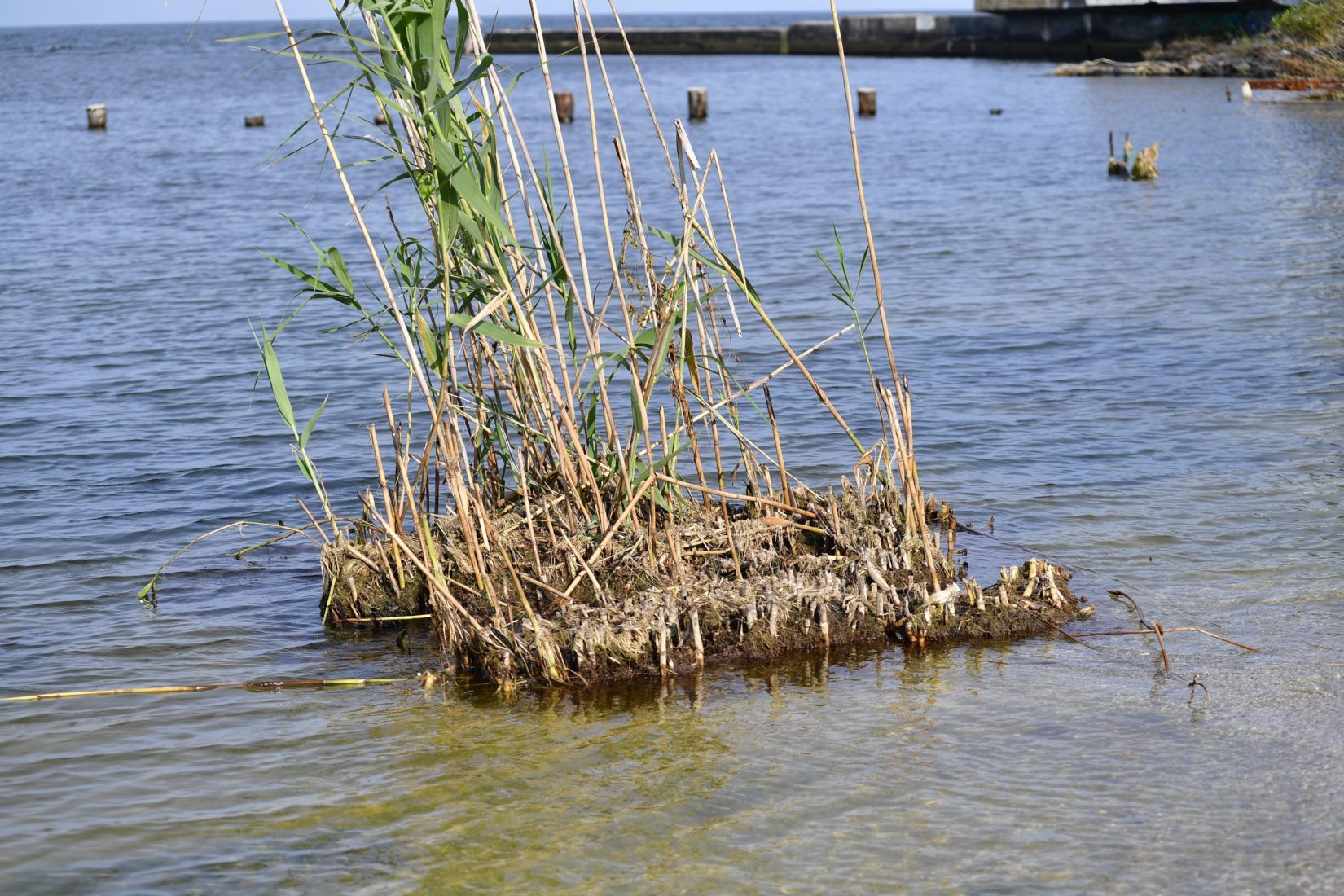
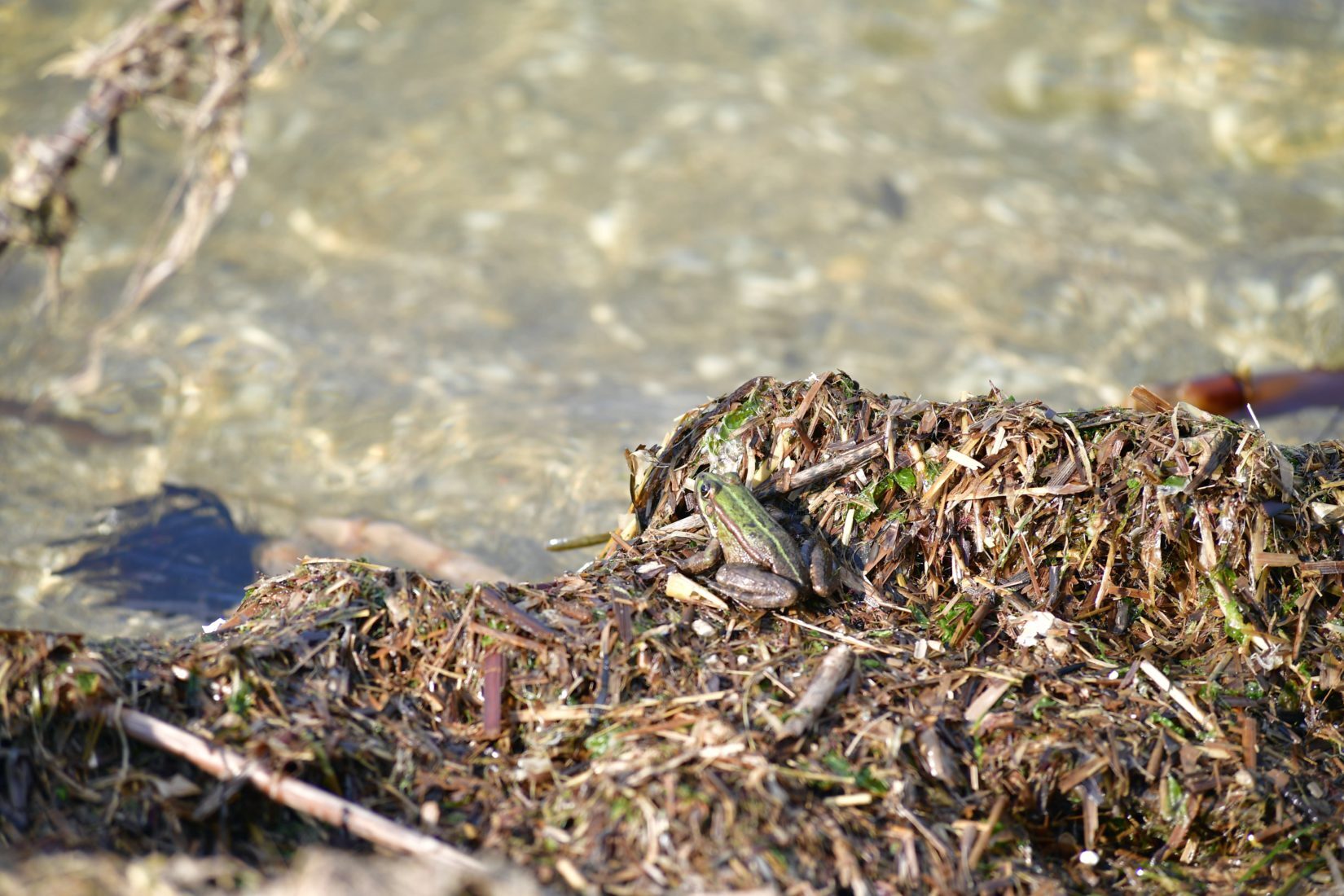
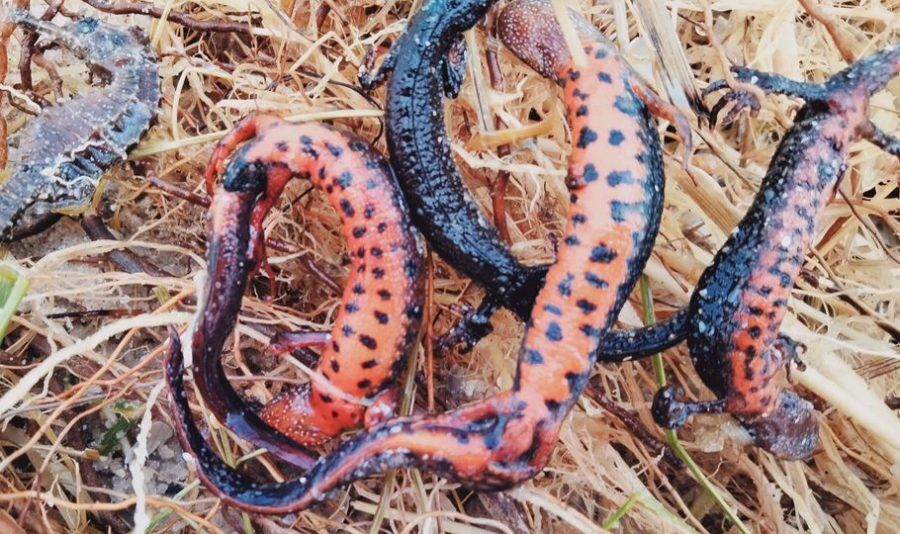
In mid-July, the head of the Green Leaf NGO, Vladyslav Balinsky, during a regular inspection of the state of the Odesa Black Sea coast, discovered a threatening phenomenon – the mass death of mussels. “About 50 % of all mussels have died in the basin of Dog Beach,” he wrote on Facebook, “The process is so large-scale that in some places limestone rocks have been exposed. I think the situation with mussels is similar on all Odesa beaches with breakwaters. In the colonies 100 metres behind the breakwater on the sea side, the number of dead mussels is much lower (up to 20%), but even so, within the desalinated sea area, it is hundreds and hundreds of tonnes. The general appearance of the colonies is terrible – they are covered with mucus like a film.”
The ecologist’s conclusion was disappointing: “The ability of the sea to cleanse itself in the waters of the Gulf of Odesa and especially its coastal area has been significantly undermined. The deposits of plant residues are a strong pollutant as a constant source of organic suspension and pose a threat to local offshore processes.”
Overall, in just 10 days after the Kakhovka disaster, about 1 million mussels died off the coast of Odesa. This is approximately 3.7 thousand tonnes of dead mussels, which is about 40% of the natural coastal mussel population in the north-western part of the Black Sea. These figures were made public by Galina Minicheva, Director of the Institute of Marine Biology, at the aforementioned roundtable discussion “The Impact of Military Operations on the Marine Ecosystems of Ukraine”.
Why are dolphins dying?
In the very first months of the full-scale war, the bodies of dead dolphins without their fins cut off began to appear on the Ukrainian Black Sea coast and on the coasts of other Black Sea countries. This meant that the cetaceans did not die because they were caught in fishermen’s nets, as was the case before. Ivan Rusev, Doctor of Biological Sciences, Head of the Research Department of the Tuzly Estuaries National Park, began to investigate the causes of dolphin deaths.

Rusev described a mechanism that can destroy the animal’s health and lead to its death: sonar hydrolocator equipped by Russian military vessels causes acoustic trauma to dolphins, which leads to a loss of ability to navigate in space, hunt fish, a drop in immunity, virus infection, and epizootics. The health of marine mammals is also adversely affected by the bombardment of the Ukrainian coast by Russian ships from the Black Sea, mine explosions, and carbon emissions from the burning Boyko towers. In total, according to Rusev’s estimates, at least 50,000 animals died in the Black Sea as a result of the war.
“In general, the largest number of stranded dolphins was recorded at the beginning of the full-scale invasion (February-October 2022), as many Russian warships and submarines were present in the Black Sea at that time, according to the authors of the book “My Friend the Black Sea”, recently presented in Odesa. – During this period, 900 dead animals were found across the Black Sea. Scientists carried out photo and video identification of the dead animals, and also took samples of damaged marine mammal organs. These samples were sent to laboratories in Germany and Italy to determine the cause of death. Among other things, it was found that the animals’ immune system was weakened, which, in turn, could be the result of prolonged stress or hidden injuries.”
Doctor of Biological Sciences, Leading Researcher at the I. Schmalhausen Institute of Zoology of National Academy of Sciences of Ukraine Pavlo Goldin, a well-known Ukrainian cetacean researcher, identifies the following causes of dolphin deaths: infectious diseases, acoustic or mine-blast injuries that affect not only internal organs and, above all, the brain, but also the cetaceans’ echolocation, and thus their ability to navigate and hunt, poisoning by toxic substances, in particular, components of rocket fuel that get into the sea, stress, loss of feeding grounds, and depletion of the food base.
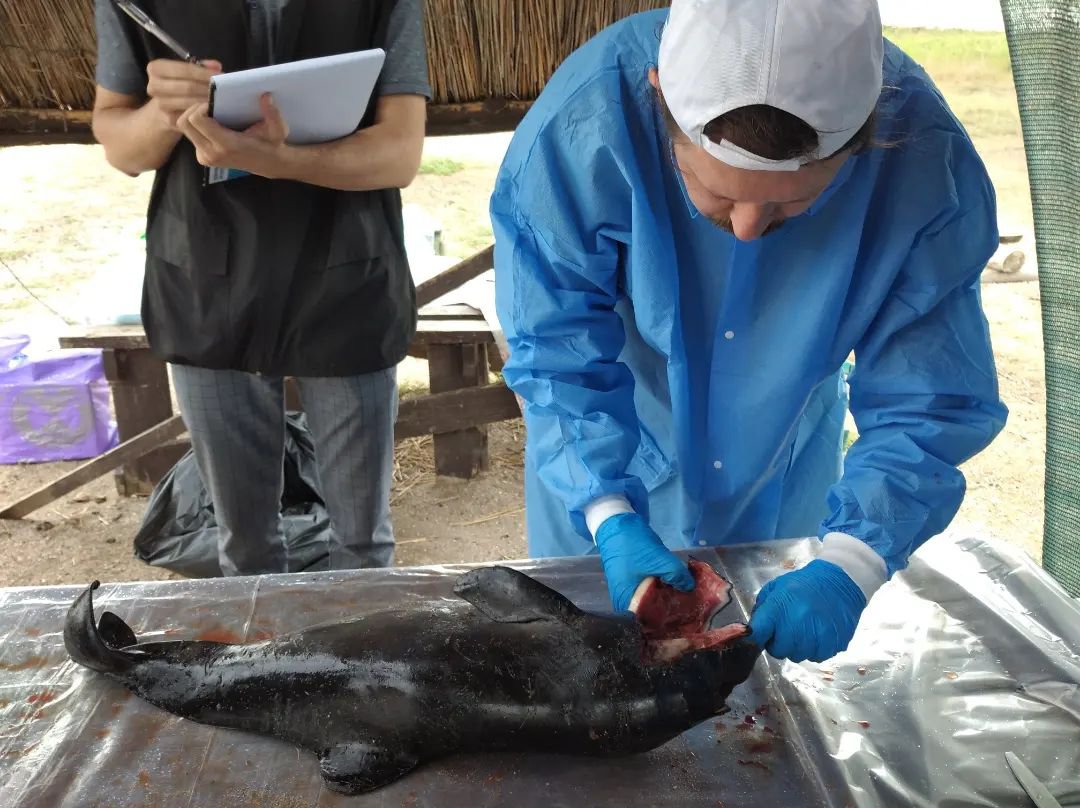
The Kakhovka disaster, according to Goldin, also affected the resilience of animals: a lot of different organic substances were released into the sea, including fertilisers from fields and sewage from city sewers. Of course, this increases the risk of infectious diseases. Organic compounds become the basis for massive algae blooms, some of which release toxins into the sea that can poison shellfish, fish, and mammals.
Viktor Komorin, who with his colleagues examined fish, mussels and dead dolphins for toxic substances after the Kakhovka disaster, says that they found thousands of times the normal amount of toxic substances in mussels.
Law enforcers consider the death of dolphins caused by war-related factors to be ecocide. Under the procedural guidance of the Odesa Prosecutor’s Office, the SBU is investigating a case under Article 441 of the Criminal Code of Ukraine on the fact of armed aggression by the Russian Federation that caused the mass death of Black Sea dolphins.
The Green Leaf NGO has created an interactive map that contains important information about the Kakhovka disaster and its aftermath, including official responses to the organisation’s inquiries. The map is intended for all researchers of this terrible terrorist act of Russia.
The sea has poisoned the pond but it hasn’t cleared up.
The situation in the marine ecosystem has improved within a year of the tragedy, environmentalists say. But, according to Vladyslav Balinsky, some processes in the sea are irreversible.
“The Dnipro-Bug estuary suffered the main blow to the ecosystem. It has become the main buffer between the Dnipro and the Black Sea,” explains Viktor Komorin. “A large amount of pollutants remained on the coast of this estuary. All this pollution still gets into the water and reaches the Odesa coast. If you look at the spectrum of pollution in the Odesa region, it used to be dominated by oil pollution, and in some places it was toxic. But now we have a large amount of organochlorine hydrocarbons and toxic metals. That is, even after a year has passed, when a large amount of toxic substances have been redistributed throughout the Black Sea, we are still being affected by that situation.”
Toxic substances that are still present in the ecosystem of the Odesa coast accumulate in marine organisms – mollusks, crustaceans, fish, dolphins – which can die from these substances.
The Marine Environmental Strategy, which Ukraine approved on 11 October 2021 to meet the requirements of the EU-Ukraine Association Agreement, includes the definition of quality descriptors to be used to determine the “good” environmental status of our marine region. There are currently 11 such characteristics of the “good” environmental status of the Black and Azov Seas. Ukrainian scientists studying the state of Ukrainian seas are now proposing to introduce a 12th descriptor into the Maritime Strategy of Ukraine – Military impact.
“The consequences of this catastrophe, which extend over thousands of square kilometres, have become apparent over the past year and are likely to persist indefinitely,” state the authors in the study of the Kakhovka dam’s destruction and its consequences – the NGOs Truth Hounds and Project Expedite Justice.
The authors of the report have assessed all the arguments for qualifying the destruction of the Kakhovka dam as a war crime. This case may be the first application by the ICC of Article 8(2)(b)(iv) of the Rome Statute, which refers to the causing of “excessive” environmental damage compared to the expected military advantage. In this way, international law may become more effective in punishing environmental crimes at the global level.
Tetiana Herasymova
The material was created with the support of Journalismfund Europe


